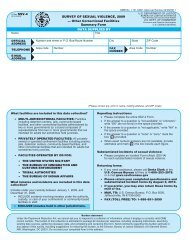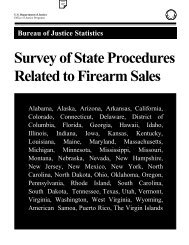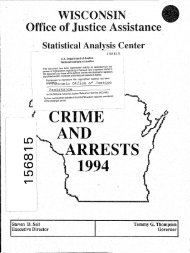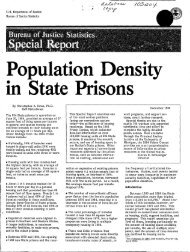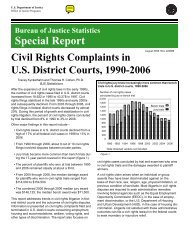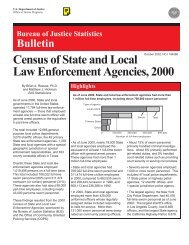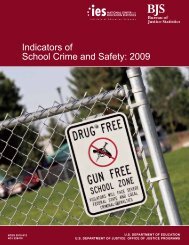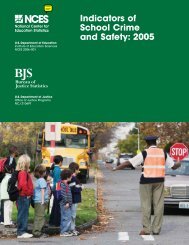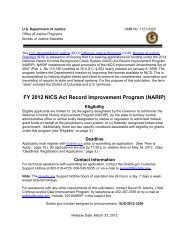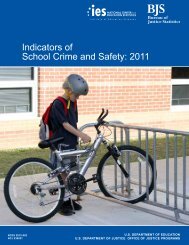Sourcebook of Criminal Justice Statistics, 1983 - Bureau of Justice ...
Sourcebook of Criminal Justice Statistics, 1983 - Bureau of Justice ...
Sourcebook of Criminal Justice Statistics, 1983 - Bureau of Justice ...
Create successful ePaper yourself
Turn your PDF publications into a flip-book with our unique Google optimized e-Paper software.
<strong>Sourcebook</strong> <strong>of</strong> <strong>Criminal</strong> <strong>Justice</strong> <strong>Statistics</strong> 198:>.. -Nation, report on the estimated number andrate <strong>of</strong> personal and household victimizations.These data are supplemented by a variety<strong>of</strong> data derived from self-report surveys ondrug and alcohol use, and other illegalactivities that are reported by severalorganizations. Agencies with specialized lawenforcement functions, such as the Securitiesand Exchange Commission, Postal InspectionService, Drug Enforcement Administration,Secret Service, and others collect limitedstatistical information on case processing andagency activities. In addition, privateorganizations such as the Association <strong>of</strong>American Railroads, American HumaneAssociation, and National Education Associationpublish data on various forms <strong>of</strong> illegal activityrelated to their organizational purposes.Information on personnel andexpenditures for the criminal justice system isfound in a variet)1 <strong>of</strong> sources. Governmentpubl ications, such as the Budget <strong>of</strong> theUnited States Government and agency annualreports, provide data on expenditures forcriminal justice-related activities. The <strong>Bureau</strong><strong>of</strong> <strong>Justice</strong> <strong>Statistics</strong>' publication, <strong>Justice</strong>Expenditure and Employment Data in theU.S., compiles data on criminal justice agencypersonnel, payroll, and expenditure. Variousspecial surveys, such as the Census <strong>of</strong> StateCorrectional Facilities, contain informationon personnel, source <strong>of</strong> funding, andexpenditures for these segments <strong>of</strong> the criminaljustice system. These sources are augmentedby surveys conducted by the i\JOtional Centerfor State Courts, the National Counc i I onCrime and Delinquency, the AmericanCorrectional Association, the National Sheriff'sAssociation, and other groups.Data on clearance and arrest rates arereported primarily in the FBI's Crime in theUnited States. In addition, agencies such asthe Drug Enforcement Administration,Immigration and Naturalization Service, andothers collect data on clearances and arrestsin cases under their jurisdiction.Court-related data for the Federalsystem come from the Administrative Office <strong>of</strong>the U.S. Courts and the Federal Prison System.Although no uniform standardized courtrepor1ing system (comparable to the UniformCrime Reporting Program) currently exists atthe State level, the <strong>Bureau</strong> <strong>of</strong> <strong>Justice</strong><strong>Statistics</strong>' publication, State Court Caseload<strong>Statistics</strong>, contains State-by-State informationrelating to the activities <strong>of</strong> State courts.Data on probation systems are providedby the Administrative Office <strong>of</strong> the U.S. Courtsand the National Probation Reports programiv<strong>of</strong> the National Council on Crime andDelinquency. Information on persons incorrectional institutions is found in a number <strong>of</strong>sources, including the Prisoners in State andFederal Institutions series publ ished by the<strong>Bureau</strong> <strong>of</strong> <strong>Justice</strong> <strong>Statistics</strong>. Information onFederal prisoners is available in the annualStatistical Report <strong>of</strong> the Federal PrisonSystem. In addition to these sources, data onprison populations and characteristics <strong>of</strong>correctional facilities and inmates are providedby surveys conducted by the AmericanCorrectional Association and numerous privateresearch groups and individual researchers.Detailed information on inmates executed andon death row is published annually by the U.S •Department <strong>of</strong> <strong>Justice</strong>, <strong>Bureau</strong> <strong>of</strong> <strong>Justice</strong><strong>Statistics</strong> series on Capital Punishmf,mt.<strong>Statistics</strong> on parole services arecollected and reported by the Unifc)rm ParoleReports program <strong>of</strong> the National Council onCrime and Delinquency, and by the AmericanCorrectional Association, and the U.S. ParoleCommissi on. Discharges from State andFederal correctional facilities are reported inthe Prisoners in State and FederalInstitutions series issued by the <strong>Bureau</strong> <strong>of</strong><strong>Justice</strong> <strong>Statistics</strong>.In the juvenile ju~ !:ice system, data on<strong>of</strong>fenses and on j uven i I es taken into custodyare reported by the Federal <strong>Bureau</strong> <strong>of</strong>Investigation's Crime in the United States.Data on the volume <strong>of</strong> cases disposed <strong>of</strong> byjuvenile courts are provided in Delinquency1980 by the National Center for Juven i Ie<strong>Justice</strong>.Juvenile correctional data are providedby a number <strong>of</strong> sources. The Children inCustody series issued by the Office <strong>of</strong> Juvenile<strong>Justice</strong> and Delinquency Prevention <strong>of</strong> the U.S.Department <strong>of</strong> <strong>Justice</strong> reports data on thenumber <strong>of</strong> juveniles held in public and privatejuvenile correctional facilities. Data on theestimated number <strong>of</strong> juveniles confined in localjails are reported in the Survey <strong>of</strong> JailI nmates, published by the U.S. Department <strong>of</strong><strong>Justice</strong>. To date there is no nationwidereporting system that collects data on parole("aftercare") outcome for juveniles.Information regarding public opinion oncriminal justice issues is obtained from avariety <strong>of</strong> groups such as The Gallup Poll, LouisHarris and Associates, the National OpinionResearch Center, the ABC-W\Jshington PostPoll, and the N3C News/Associated Press Pollas well as a variety <strong>of</strong> governmental agenciesand conmissions. Topics examined in theseopinion surveys include fear <strong>of</strong> crime andvictimization, public attitudes about crime andIII'~!II· 1Prefaceits ca~ses, the performance <strong>of</strong> law enforcementage,ncles and the U.S. Supreme Court, capital<strong>Justice</strong> data are (a) lacking in a number <strong>of</strong>punlshn:ent, and gun ownership and gun control.Important areas; (b) uneven in terms <strong>of</strong> qualityFigures A and B provide theand comprehensiveness; and, (c) not uniformlyS0l!RC~~OOK uS,er, with an idea <strong>of</strong> theco!lected at the Federal, State, and localavaJla?Jllty <strong>of</strong> criminal justice data from a !evels o~ government. For more deta i ledsystemic perspective. In Figure A, the flowchart~rl~inally published by the President'sI~formatlon on the contents <strong>of</strong> the sourcesdiscussed above and on criminal justice dataCon:m,lsslo!", on Law Enforcement andSources generally, readers are advised toAdministration <strong>of</strong> <strong>Justice</strong> in 1967 has beenconsult the Annotated List <strong>of</strong> Sources andReferences in this volume.adapted to indicate where data are avai lableand where gaps exist. In this figure, asterisksOrganization <strong>of</strong> the SOlRCEBOO



